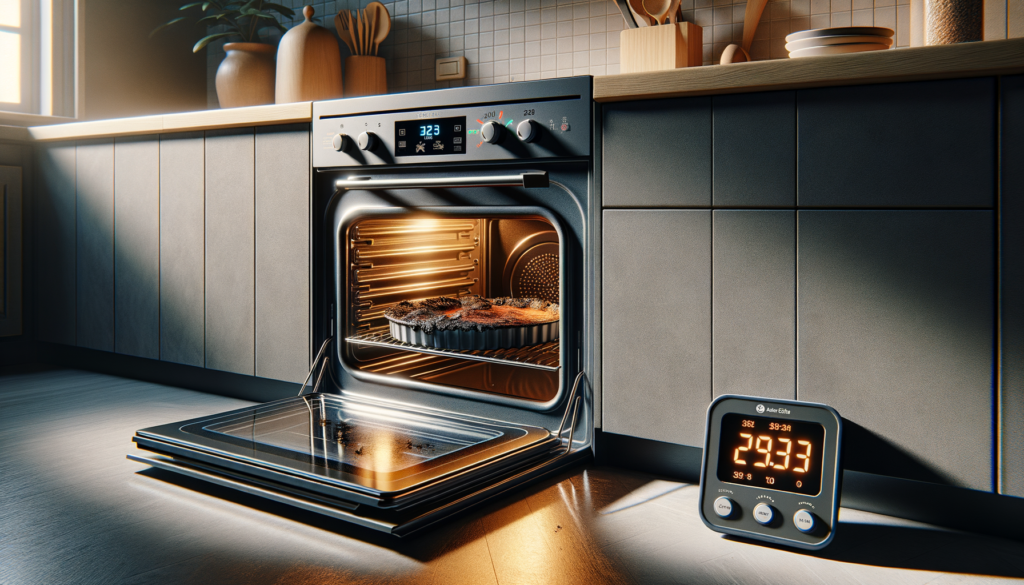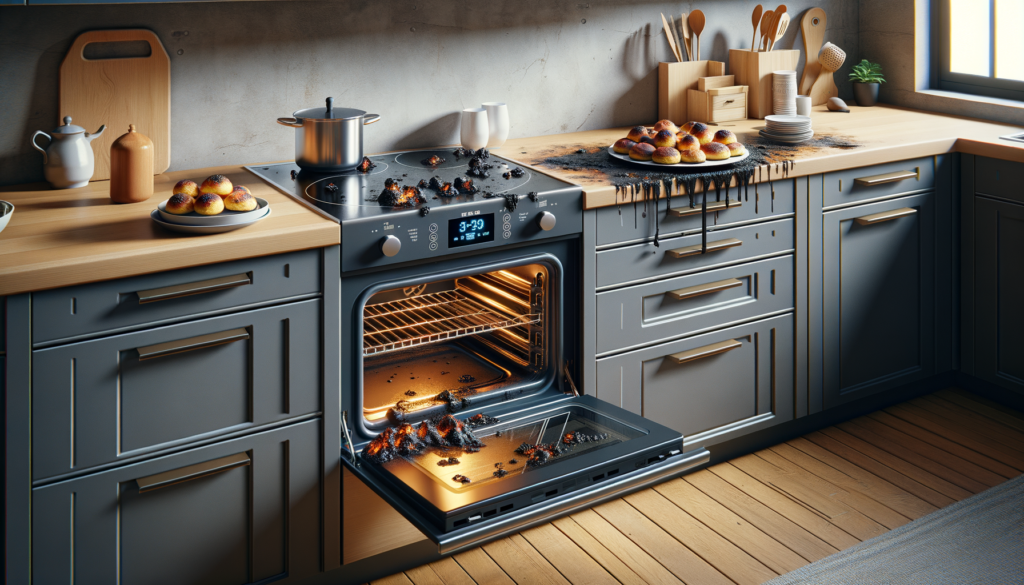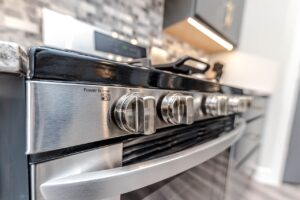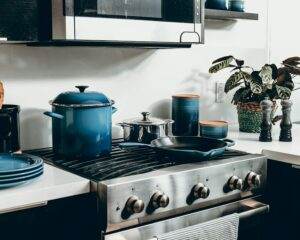
Troubleshooting 10 Common Oven Problems: Repair Made Easy
Ovens are fundamental kitchen appliances used for baking, roasting, and reheating food. Like all appliances, ovens can develop problems that interfere with normal operation. This guide addresses common oven issues, identifies their causes, and offers practical repair solutions. Regular maintenance and troubleshooting can improve oven performance and longevity. Many oven problems can be resolved through basic troubleshooting and simple repairs. Understanding typical malfunctions allows you to diagnose and address issues systematically. This guide provides information to help you identify problems and implement effective solutions.
Table of Contents
- Key Takeaways
- Oven Not Heating Up
- Uneven Cooking or Hot Spots
- Oven Door Not Closing Properly
- Oven Not Maintaining Temperature
- Oven Not Turning On
- Burners Not Lighting
- Strange Odors or Smoke Coming from Oven
- Oven Display or Controls Not Working
- Self-Cleaning Function Not Working
- Conclusion and Final Tips for Oven Maintenance
- FAQs
- What are some common problems that ovens experience?
- Why is my oven not heating up?
- How can I fix an oven that heats unevenly?
- What should I do if my oven door won’t close properly?
- How do I know if my oven temperature is inaccurate?
- Can I repair oven problems myself or should I call a professional?
Key Takeaways
- Common oven issues include heating problems, uneven cooking, and door sealing failures.
- Troubleshooting steps often involve checking power supply, heating elements, and thermostat settings.
- Uneven cooking can result from faulty heating elements or poor oven calibration.
- Regular maintenance, such as cleaning and inspecting door seals, helps prevent many oven malfunctions.
- Addressing control panel and self-cleaning function issues may require professional repair or replacement parts.
- Quick start checklist: verify the breaker/GFCI, confirm gas supply (for gas), ensure the door is fully closed, and check for Child Lock, Sabbath, or Demo Mode.
- Modern ovens may show error codes in the display or app; review these diagnostics before replacing parts (e.g., temperature sensor and door-lock alerts).
- After a self-clean cycle, no-heat issues often trace to an open thermal cutoff (thermal fuse) or a failed door-lock switch.
- Ovens cycle above and below setpoint by design; use a thermometer and the oven’s temperature offset to fine-tune before swapping parts.
Oven Not Heating Up
One of the most frustrating issues you may encounter is when your oven refuses to heat up. This problem can stem from several causes, including a faulty heating element, a malfunctioning thermostat, or even an issue with the power supply. If you find yourself in this situation, the first step is to check if the oven is receiving power. Ensure that it is plugged in and that the circuit breaker hasn’t tripped. Sometimes, a simple reset can resolve the issue. If power isn’t the problem, you may need to inspect the heating elements. In electric ovens, these elements are responsible for generating heat. If they appear damaged or are not glowing red when turned on, they may need replacement. For gas ovens, check if the igniter is functioning properly; many models use a hot-surface (glow-bar) igniter that should glow bright orange. If it glows weakly or never reaches temperature, it may be faulty and will not open the gas valve. By systematically checking these components—and reviewing any error codes shown on the display or companion app—you can often pinpoint the issue and take appropriate action. Summary: confirm power, inspect element or igniter, and review on-screen/app diagnostics before replacing parts.
Uneven Cooking or Hot Spots

Have you ever noticed that your baked goods come out unevenly cooked? Perhaps one side of your casserole is bubbling while the other remains cold. This issue often arises from uneven heat distribution within the oven, leading to hot spots that can ruin your culinary creations. Several factors can contribute to this problem, including a malfunctioning fan in convection ovens or improper placement of racks. To address uneven cooking, start by ensuring that your oven is level. An unlevel oven can cause food to cook unevenly. You can use a spirit level to check this and adjust the feet of the oven as necessary. Additionally, consider rotating your dishes halfway through cooking to promote even heat exposure. Modern ovens intentionally cycle temperature above and below the setpoint; verify actual temperature with an oven thermometer and, if needed, use the temperature offset setting (often adjustable ±5–35°F) rather than replacing parts immediately. Summary: level the oven, use proper rack placement, rotate pans, and fine-tune with an oven thermometer and temperature offset.
Oven Door Not Closing Properly
An oven door that doesn’t close properly can lead to heat loss and inefficient cooking. If you notice that your door doesn’t seal tightly, it could be due to worn-out gaskets or hinges that need adjustment. A loose door not only affects cooking times but can also pose safety risks if hot air escapes. To troubleshoot this issue, start by inspecting the door gasket for any signs of wear or damage. If it appears cracked or brittle, replacing it may be necessary to ensure a proper seal. Additionally, check the hinges for any misalignment; sometimes, tightening screws or adjusting the hinges can resolve the problem. On models with door-lock sensors, an incorrect door status can also prevent the oven from starting. Summary: replace a worn gasket, adjust hinges, and confirm the door-lock sensor reads closed.
Oven Not Maintaining Temperature
| Oven Problem | Common Cause | Symptoms | Repair Steps | Estimated Time to Fix | Tools Needed |
|---|---|---|---|---|---|
| Oven Not Heating | Faulty heating element or broken thermostat | Oven does not reach set temperature | Check and replace heating element or thermostat | 30-60 minutes | Screwdriver, multimeter |
| Oven Temperature Inaccurate | Malfunctioning temperature sensor or calibration issue | Food undercooked or overcooked | Calibrate oven temperature or replace sensor; use temperature offset if available | 20-40 minutes | Multimeter, user manual |
| Oven Door Won’t Close Properly | Damaged door seal or misaligned hinges | Heat escapes, longer cooking times | Replace door gasket or adjust hinges; confirm door-lock sensor | 15-30 minutes | Screwdriver, replacement gasket |
| Oven Light Not Working | Burnt out bulb or faulty wiring | Light does not turn on when oven is in use | Turn off power at the breaker and verify no voltage; replace bulb; inspect socket and wiring if still out | 10-20 minutes | Replacement bulb, screwdriver, multimeter |
| Oven Self-Cleaning Function Not Working | Faulty door lock or control board issue | Self-clean cycle does not start or stops abruptly | Check door lock mechanism or reset control board; review error codes | 30-60 minutes | Screwdriver, multimeter |
If your oven struggles to maintain a consistent temperature, it can lead to undercooked or overcooked meals. This issue may arise from a faulty thermostat or temperature sensor that fails to accurately gauge the internal heat levels. When this happens, it’s essential to diagnose the problem quickly to avoid ruining your dishes. To determine if your oven is indeed maintaining temperature correctly, consider using an oven thermometer for an accurate reading. Place it inside the oven and compare its reading with the set temperature. If there’s a significant discrepancy, it may indicate a malfunctioning thermostat that requires replacement. Keep in mind that ovens cycle above and below the setpoint by design; try the temperature offset in your settings menu before replacing parts. Regular calibration of your oven can also help ensure that it operates within the desired temperature range. Summary: verify with a thermometer, apply a temperature offset, then test the sensor or thermostat if variance persists.
Oven Not Turning On

When you press the bake button and nothing happens, it can be incredibly disheartening. An oven that won’t turn on could be due to several factors, including electrical issues or problems with internal components like the control board or igniter. The first step in troubleshooting this issue is to check for power supply problems. Ensure that your oven is plugged in and that there are no blown fuses or tripped circuit breakers in your home’s electrical panel. If everything appears normal on the power front, confirm the oven isn’t in Child Lock, Sabbath, or Demo Mode, and that the door is fully closed with the lock sensor reading correctly. For connected models, review any error codes in the display or app; codes related to temperature sensors or door locks can prevent a start. In gas ovens, many use a hot-surface (glow-bar) igniter that glows orange—no clicking. If it glows weakly or never reaches temperature, it may be faulty. Spark-type systems do click; if you hear repeated clicking without ignition, inspect the spark module and electrode. If the failure occurred right after a self-clean cycle, test the thermal cutoff (thermal fuse) and door-lock switch for continuity and replace if open. Summary: verify modes and door status, read error codes, and test igniter or safety cutoffs before replacing boards.
Burners Not Lighting
For those who rely on gas ovens and ranges, burners that refuse to light can be particularly frustrating. This issue often arises from a clogged burner or a malfunctioning igniter. If you find yourself in this predicament, start by checking for any food debris or grease buildup around the burner area that could be obstructing ignition. Cleaning the burner caps and ensuring they are properly seated can often resolve lighting issues. If cleaning doesn’t work, inspect the igniter; it should glow bright orange on oven igniters or produce a consistent spark on cooktop burners. If it doesn’t glow or clicks without igniting gas, it may need replacement. Regular maintenance of burners can prevent these issues from arising in the first place. Summary: clean and reseat burner parts, confirm igniter operation, and replace a weak glow-bar or failed spark component.
Strange Odors or Smoke Coming from Oven
Encountering strange odors or smoke emanating from your oven can be alarming and should not be ignored. These smells could indicate food residue burning off or more serious issues like electrical problems or overheating components. If you notice smoke while preheating or cooking, it’s essential to act quickly. First, turn off the oven and allow it to cool down before investigating further. Check for any food spills or debris inside that may be causing smoke; cleaning these areas thoroughly can often eliminate unpleasant odors during cooking. However, if you suspect electrical issues—such as burnt wires or components—it’s crucial to consult a professional technician for safety reasons. Summary: power down, clean residue, ventilate, and call a pro if you suspect electrical damage.
Oven Display or Controls Not Working
A malfunctioning display or unresponsive controls can render your oven nearly useless. If you find that buttons aren’t responding or the display is blank, it could be due to power issues or internal electronic failures. Start by checking if there’s power reaching the appliance; sometimes, a simple reset of the circuit breaker can resolve minor electronic glitches. If power isn’t the issue, inspect the control panel for any visible damage or loose connections. In some cases, replacing a faulty control board may be necessary to restore functionality. Many modern ovens provide diagnostics and error codes that identify failed sensors or locks; review these before ordering parts. Keeping your oven’s control panel clean and free from moisture can also help prevent future issues. Summary: reset power, review diagnostics/error codes, and service or replace the control board if unresponsive.
Self-Cleaning Function Not Working
The self-cleaning feature on modern ovens is a convenient way to maintain cleanliness without scrubbing away at stubborn stains manually. However, if this function isn’t working correctly, it can be frustrating. Common reasons for a malfunctioning self-cleaning feature include door lock issues or problems with internal sensors. If your oven won’t enter self-cleaning mode, check if the door locks properly; many ovens have safety mechanisms that prevent self-cleaning if the door isn’t securely closed. Additionally, inspect any error codes displayed on the control panel; these codes can provide insight into what might be wrong with the self-cleaning function. If the oven fails to heat after self-clean, test the thermal cutoff (thermal fuse) and the door-lock switch for continuity and replace any open components. Regular maintenance of your oven will help ensure that all features operate smoothly. Summary: confirm door lock, read error codes, and test thermal cutoffs after self-clean.
Conclusion and Final Tips for Oven Maintenance
In conclusion, understanding how to troubleshoot common oven problems empowers you as a home cook and ensures that your culinary adventures continue uninterrupted. From addressing heating issues to maintaining proper seals on doors and ensuring all functions work correctly, being proactive about maintenance will extend your oven’s lifespan and enhance its performance.
Regular cleaning and inspections are key components of effective oven maintenance.
Make it a habit to clean spills promptly and check components periodically for wear and tear. Always work safely: turn off power at the breaker, verify zero voltage with a multimeter, and shut off gas if you smell gas or suspect a leak.
By staying vigilant about potential issues and addressing them early on, you’ll enjoy many successful meals from your trusty oven for years to come.
Remember that when in doubt or faced with complex repairs beyond your expertise, consulting a professional technician is always a wise choice for safety and peace of mind. If you’re in San Diego and need help, professional local oven repair is available throughout the city and nearby neighborhoods. If you’re experiencing issues with your oven, you might find it helpful to read about some general tips for efficient appliance use in our article on Appliance Tips for Efficient Use. This resource provides valuable insights that can help you maintain your appliances, including your oven, ensuring they operate smoothly and efficiently.
FAQs
What are some common problems that ovens experience?
Common oven problems include the oven not heating, uneven cooking or baking, the oven door not closing properly, the oven temperature being inaccurate, and the oven light not working.
Why is my oven not heating up?
An oven may not heat up due to a faulty heating element, a broken thermostat, issues with the electrical connection, or a malfunctioning control board. On gas models, a weak hot-surface (glow-bar) igniter can also prevent the gas valve from opening.
How can I fix an oven that heats unevenly?
Uneven heating can be caused by a faulty heating element, a broken convection fan, or incorrect oven calibration. Checking and replacing damaged parts or recalibrating the oven temperature can help. Use an oven thermometer and apply the temperature offset in settings before replacing parts.
What should I do if my oven door won’t close properly?
If the oven door won’t close properly, inspect the door hinges and seals for damage or warping. Replacing worn-out door gaskets or repairing hinges can resolve the issue. Confirm that the door-lock sensor reports closed on models with lock detection.
How do I know if my oven temperature is inaccurate?
If food is consistently overcooked or undercooked, or if baking times are off, the oven temperature may be inaccurate. Using an oven thermometer to compare the set temperature with the actual temperature can help diagnose this. Remember that ovens cycle by design; apply the calibration offset if your model allows.
Can I repair oven problems myself or should I call a professional?
Minor issues like replacing a heating element or door gasket can often be handled by someone with basic DIY skills. However, for electrical problems or complex repairs, it is safer to call a professional technician. Always disconnect power at the breaker and verify no voltage before any inspection.



